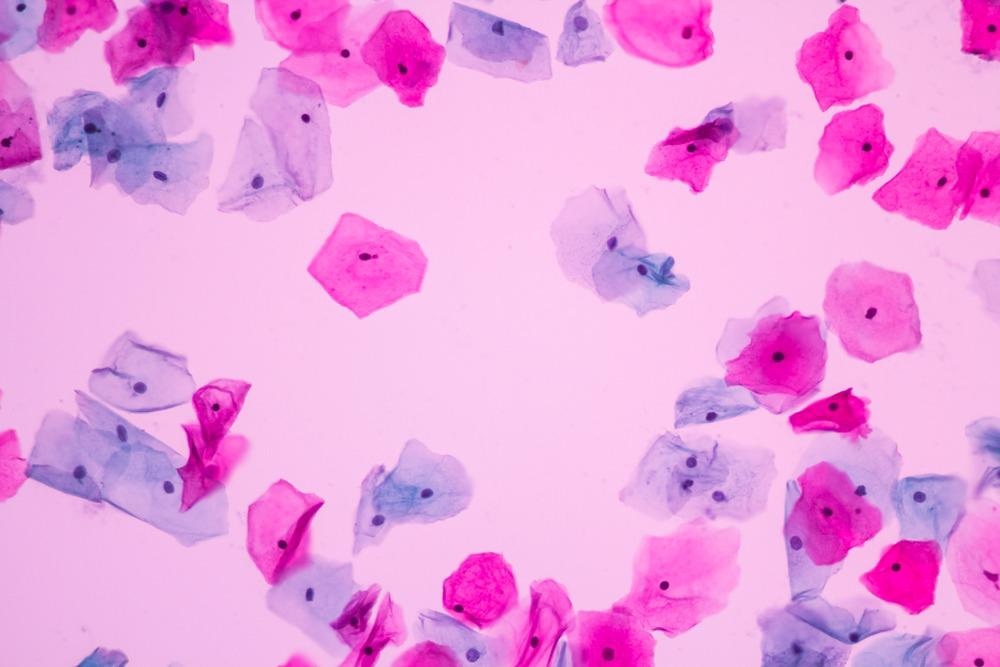Gold nanoparticles (GNPs) have found many applications in the biomedical field. Carboxyl-polyethylene glycol-thiol (PEG)-coated GNPs prolong their circulation and enhance cellular uptake.

Study: Cellular Uptake and Cytotoxicity of PEGylated Gold Nanoparticles in C33A Cervical Cancer Cells. Image Credit: Komsan Loonprom/Shutterstock.com
In an accepted manuscript recently in the journal Nano Express, the researchers investigated the cytotoxic activity of the PEG-coated GNPs on human cervical cancer C33A cells and compared the results with citrate-capped GNPs.
Properties and Biomedical Applications of GNPs
The optical and thermal properties of GNPs and versatility in synthesizing GNPs of various sizes and shapes offer tremendous benefits in biomedical research. The inertness of GNPs helps attain physicochemical stability. Owing to their small size, formulations involving GNPs attribute a high surface area to volume ratio that improves the loading of drugs or other bioconjugated moieties, thus increasing stability, drug solubility, and pharmacokinetic properties.
At resonance wavelength, the localized surface plasmon resonance (LSPR) of GNPs allows strong absorbance and scattering of light, which is exploited in applications of surface-enhanced spectroscopies to photothermal heating. Moreover, GNP’s plasmonic photothermal heating is utilized in cancer therapy applications, wherein GNPs with absorption and scattering in the near-infrared (NIR) region are used. Additionally, previous studies on GNPs confirmed the influence of physicochemical characteristics on their cellular uptake.
PEGylated Versus Citrate-capped GNPs
In the present study, the authors employed laser scanning confocal microscopy (LSCM) and image flow cytometry (IFC) analysis to evaluate the spatial distribution and cellular uptake of PEGylated GNPs by C33A cell lines. They focused on the effect of PEGylation on GNPs to increase their stability in the cellular medium and aqueous solution.
Dark field scattering images were captured for C33A cell lines after incubating them with PEGylated and citrate-capped GNPs. The viability of C33A cells treated with PEGylated and citrate-capped GNPs was evaluated by employing IFC.
Moreover, the team detected apoptotic cells in their early and late stages by performing Zombie Aqua staining and Alexa Fluor 488 Annexin V protocols. They demonstrated the cytotoxic effects of PEGylated GNPs on C33A cancer cells and compared the obtained results with citrate-capped GNPs. This comparative assessment involved the modification of GNP surface chemistry that impacted their behavior in a cellular environment.
The study allowed the researchers to gain profound knowledge on necrosis and apoptosis at the single-cell level, whose accessibility is restricted otherwise by other methods.
Research Findings
Scanning electron microscope (SEM) images confirmed that the diameter of citrate-capped GNPs was 30 nanometers. The hydrodynamic sizes of citrate and PEG-coated GNPs in aqueous media were 43.82 and 78.82 nanometers, respectively, as measured by a high-performance dynamic light scattering (DLS) system.
Herein, the hydrodynamic diameter includes surface-bound molecules and the associated water molecules, which corroborates for enhanced hydrodynamic diameter over the metal NP itself (measured by SEM). Ultraviolet-visible (UV-vis) spectra showed optical absorbance peaks for citrate-capped and PEGylated GNPs in aqueous media at 527 and 529 nanometers, respectively.
The redshift of LSPR confirmed the conjugation of PEG polymer to NPs. The PEGylated GNPs exhibited improved stability than citrate-capped GNPs, suggesting the presence of a protective outer coating.
The zeta potential of citrate-capped and PEGylated GNPs were -31.33 millivolts and -43.38 millivolts, respectively. The functionalized PEGylated GNPs showed increased colloidal stability than citrate-capped GNPs due to the outer PEG polymer layer held via strong gold-sulfur bonds. On the other hand, the citrate ions on citrate-capped GNPs were attached via weak electrostatic forces, leading to the aggregation of GNPs. Furthermore, washing PEGylated and citrate-capped GNPs resulted in severe aggregation in the citrate-capped GNP solution than in the PEGylated GNP solution.
PEGylated and citrate-capped GNP’s cellular uptake by C33A cells were evaluated from LSCM imaging. Moreover, the GNP scattering was observed in darkfield scattering images, acquired at a wavelength of 514 nanometers that corresponded to GNP’s plasmon resonance wavelength. The results revealed that the citrate GNPs were densely concentrated and unstable in cellular media compared to PEGylated GNP; this variation in stability is due to the aggregation of NPs. The PEGylated GNPs showed better intracellular stability and spatial distribution than citrate GNPs.
The cell viability and apoptosis of C33A cells exposed to citrate-capped and PEGylated GNPs were examined through IFC using Zombie Aqua and Alexa Fluor 488-labeled Annexin V. The results indicated that PEGylated GNPs induced notable necrosis and apoptosis of C33A cells compared to citrate-capped GNPs. Moreover, PEG-GNPs induced the upregulation of intracellular proteins because of their reaction with the Zombie Aqua, which is an amine-reactive fluorescent dye.
In conclusion, the researchers introduced the impact of citrate-capped and PEGylated GNPs on cervical cancer cells. They demonstrated the cellular uptake of functionalized PEG GNPs followed by their uniform distribution throughout the cells without aggregation. The PEGylated GNPs can also be conjugated with antibodies and other moieties of interest.
Reference
Shaquan David, Devanshi Yogeshkumar Patel, Sandra Cardona, Neil Kirby, and Kathryn M Mayer (2022). Cellular Uptake and Cytotoxicity of PEGylated Gold Nanoparticles in C33A Cervical Cancer Cells. Nano Express. https://iopscience.iop.org/article/10.1088/2632-959X/ac7738
Disclaimer: The views expressed here are those of the author expressed in their private capacity and do not necessarily represent the views of AZoM.com Limited T/A AZoNetwork the owner and operator of this website. This disclaimer forms part of the Terms and conditions of use of this website.